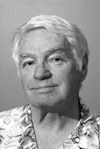Southern California Dreamin’
WHERE ARE WE, ANYWAY? Look, there are a few things I feel strongly about. One of them is: This is Southern California. Not “Central California” or the “Central Coast,” whatever that is. It bugs me to no end when I read L.A. Times surveys of voting patterns, weather, or housing prices. The Times goes as far as Ventura, and then stops.

Not that I need the Times’ validation of where we live, but since the paper circulates here, how can it ignore us? I call it serious dissing and I want the editors to shape up. Pay us a visit. Take a look at the waving palm trees, the broad, sandy beaches, the mild (usually) weather. The sunny warmth from our south-facing location. The surfers. The beach volleyball players.
Let them deny that this isn’t Southern California. I grant you, make the turn north at Gaviota on Highway 101 and things change. The shores are wilder, the winds stronger. There’s a coolness in the air, even in summer. Politics change, too, as anyone who’s trekked to Santa Barbara County’s northern country knows.
I gaze out to see the palm trees swaying on East Beach, sun glistening on the ocean, and Santa Cruz Island beyond like a gigantic sea serpent, faint smoke curling up from the barbecue grills, young figures leaping around the volleyball nets, and I know this is Southern California.
Take that, L.A. Times.
AT THE FOOT OF A MOUNTAIN: Ah, but there’s a different kind of beauty to the north. At the foot of Figueroa Mountain, Midlands School sits on 5,896 acres of wildlife habitat and rare oak woodlands. It’s next to the 5,896-acre Sedgwick Reserve. You can help preserve the Midlands land by donating money to buy a conservation easement that would protect the land from future development but not affect the school, its farm, and a cattle grazing lease. (The property is part of an 11,000-acre conservation easement project where the Land Trust is working with four ranch owners west of Los Alamos.) The nonprofit Land Trust for Santa Barbara County and Trust for Public Land have launched a $4.6 million campaign. Send donations to the Land Trust at PO Box 91830, S.B., CA 93190.
SINGLES CITY: The renovated, spruced-up bar at Canary Hotel (formerly the Andaluc-a) has become arguably the newest, hottest singles hangout in town. And a well-dressed, upscale crowd to boot. The Canary’s revamped restaurant, Coast (formerly 31 West) has reopened with a relaxed atmosphere, quick service from a well-trained staff, and a menu that’s got to be the most affordable of any fine dining room in town. Good wine list, too. Helping with the transition is talent from the Canary’s sister hotel in Santa Monica, Casa Del Mar. Sue and I gave the fish a passing grade (salmon for her, halibut for me) and as we tucked in, who should walk up but Film Fest Executive Director Roger Durling and Indy writer D.J. Palladino. Coast is getting a rep.
GETTING YOUR GOAT: Remember Betsy Kain’s campaign to raise money to buy 500 goats to help widows and orphans left destitute by Rwanda’s 1994 genocide? “Because I do volunteer work in Rwanda, I have seen extreme poverty and malnutrition in this very poor country,” Betsy told me. Her church, All Saints-by-the-Sea in Montecito, is affiliated with a nonprofit. Thirty bucks will buy a goat. I sent in $30 for my wife Sue’s first Christmas gift goat. Since its inception, Goats for Gifts has far surpassed the target of 500. “Our count stands at 927,” Betsy said. Tax-deductible checks can be addressed to Jubilee Campaign U.S.A., “Goats for Gifts,” and sent to David Kain at 507 Carriage Hill Court, S.B., CA 93110.
KEEPING ‘EM SMALLER: So, how to keep Santa Barbara from exploding with the kind of monstrosities we’re seeing on Chapala Street? A group is backing a charter amendment reducing building heights-and you can be sure the greed-heads will fight this. But the League of Women Voters says it’s “essential to protect the small-town ambiance and historic importance of Santa Barbara.” Money and about 6,000 signatures are needed to put the measure on the November ballot. In general, it would limit building in commercial and industrial areas to 45 feet from 60 feet and cut the limit in the historic El Pueblo Viejo area to 40 feet.
REAGAN’S DISCIPLE: To what extent did George W. Bush model his presidency after Ronald Reagan and to what extent did he succeed? Reagan biographer and former White House correspondent Lou Cannon of Summerland and his son, Carl, take on the legacy question in the new book, Reagan Disciple: George W. Bush’s Troubled Quest for a Presidential Legacy (PublicAffairs, New York; 400 pages; $27.95). Carl Cannon is Washington bureau chief of Reader’s Digest and author of two books, including Boy Genius: Karl Rove, the Architect of George W. Bush’s Remarkable Political Triumphs.



